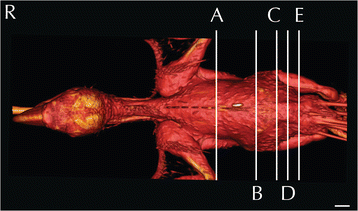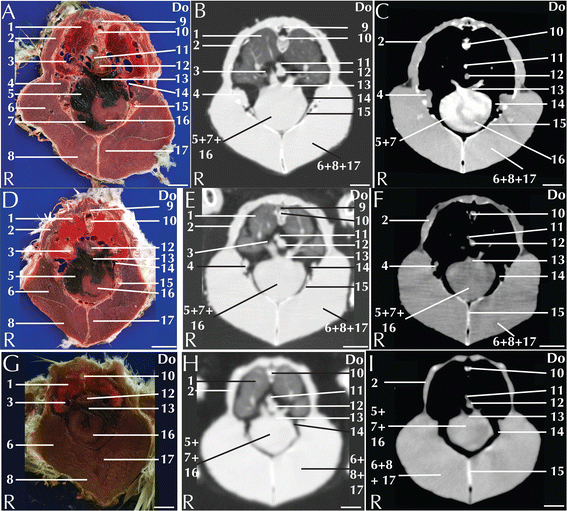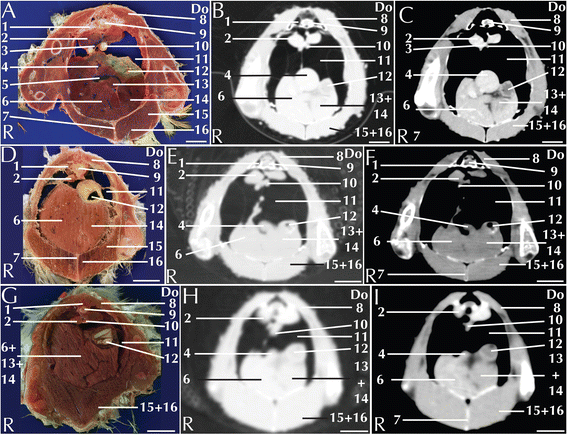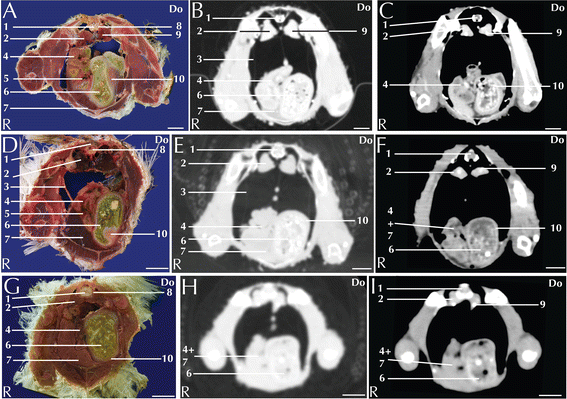Normal computed tomographic features and reference values for the coelomic cavity in pet parrots
- PMID: 27596377
- PMCID: PMC5011859
- DOI: 10.1186/s12917-016-0821-6
Normal computed tomographic features and reference values for the coelomic cavity in pet parrots
Abstract
Background: The increasing popularity gained by pet birds over recent decades has highlighted the role of avian medicine and surgery in the global veterinary scenario; such a need for speciality avian medical practice reflects the rising expectation for high-standard diagnostic imaging procedures. The aim of this study is to provide an atlas of matched anatomical cross-sections and contrast-enhanced CT images of the coelomic cavity in three highly diffused psittacine species.
Results: Contrast-enhanced computed tomographic studies of the coelomic cavity were performed in 5 blue-and-gold macaws, 4 African grey parrots and 6 monk parakeets by means of a 4-multidetector-row CT scanner. Both pre- and post-contrast scans were acquired. Anatomical reference cross-sections were obtained from 5 blue-and-gold macaw, 7 African grey parrot, and 9 monk parakeet cadavers. The specimens were stored in a -20 °C freezer until completely frozen and then sliced at 5-mm intervals by means of a band saw. All the slices were photographed on both sides. Individual anatomical structures were identified by means of the available literature. Pre- and post-contrast attenuation reference values for the main coelomic organs are reported in Hounsfield units (HU).
Conclusions: The results provide an atlas of matched anatomical cross-sections and contrast-enhanced CT images of the coelomic cavity in three highly diffused psittacine species.
Keywords: African grey parrot; Blue-and-gold macaw; Coelomic cavity; Computed tomography; Monk parakeet.
Figures







Similar articles
-
Computed tomographic anatomy of the heads of blue-and-gold macaws (Ara ararauna), African grey parrots (Psittacus erithacus), and monk parakeets (Myiopsitta monachus).Am J Vet Res. 2016 Dec;77(12):1346-1356. doi: 10.2460/ajvr.77.12.1346. Am J Vet Res. 2016. PMID: 27901394
-
Comparative evaluation of the cadaveric and computed tomographic features of the coelomic cavity in the green iguana (Iguana iguana), black and white tegu (Tupinambis merianae) and bearded dragon (Pogona vitticeps).Anat Histol Embryol. 2013 Dec;42(6):453-60. doi: 10.1111/ahe.12037. Epub 2013 Feb 14. Anat Histol Embryol. 2013. PMID: 23410482
-
Computed Tomographic Characteristics of Normal Lungs in Blue and Yellow Macaws (Ara ararauna).J Avian Med Surg. 2025 Mar;39(1):25-30. doi: 10.1647/AVIANMS-D-24-00030. J Avian Med Surg. 2025. PMID: 40085120
-
Computed tomography of the coelomic cavity in healthy veiled chameleons (Chamaeleo calyptratus) and panther chameleons (Furcifer pardalis).Open Vet J. 2023 Sep;13(9):1071-1081. doi: 10.5455/OVJ.2023.v13.i9.2. Epub 2023 Sep 30. Open Vet J. 2023. PMID: 37842108 Free PMC article. Review.
-
Psittacine incubation and pediatrics.Vet Clin North Am Exot Anim Pract. 2012 May;15(2):163-82, v. doi: 10.1016/j.cvex.2012.04.002. Vet Clin North Am Exot Anim Pract. 2012. PMID: 22640534 Review.
Cited by
-
A Cadaveric Study Using Anatomical Cross-Section and Computed Tomography for the Coelomic Cavity in Juvenile Cory's Shearwater (Aves, Procellariidae, Calonectris borealis).Animals (Basel). 2024 Mar 11;14(6):858. doi: 10.3390/ani14060858. Animals (Basel). 2024. PMID: 38539956 Free PMC article.
-
Cross-Sectional Anatomy and Computed Tomography of the Coelomic Cavity in Juvenile Atlantic Puffins (Aves, Alcidae, Fratercula arctica).Animals (Basel). 2023 Sep 15;13(18):2933. doi: 10.3390/ani13182933. Animals (Basel). 2023. PMID: 37760335 Free PMC article.
-
Radiographic and tomographic findings of excretory urography of avian kidneys after induced nephropathy in broiler chicken as a model.Vet Med Sci. 2025 Jan;11(1):e70036. doi: 10.1002/vms3.70036. Vet Med Sci. 2025. PMID: 39560332 Free PMC article.
-
A Review and Case Study of 3D Imaging Modalities for Female Amniote Reproductive Anatomy.Integr Comp Biol. 2022 May 10;62(3):542-58. doi: 10.1093/icb/icac027. Online ahead of print. Integr Comp Biol. 2022. PMID: 35536568 Free PMC article.
References
-
- Groskin R. Prologue. In: Ritchie BW, Harrison GJ, Harrison LR, editors. Avian medicine: principle and application. 1. Lake Worth: Wingers publishing inc; 1994. pp. 17–25.
-
- Raftery A. The initial presentation: triage and critical care. In: Harcourt-Brown N, Chitty J, editors. BSAVA Manual of Psittacine Birds. 2. Gloucester: British small animal veterinary association; 2005. pp. 35–49.
-
- Alonso-Farré JM, Gonzalo-Orden M, Barreiro-Vázquez JD, Ajenjio JM, Barreiro-Lois A, Llarena-Reino M, Degollada E. Cross-sectional anatomy, computed tomography and magnetic resonance imaging of the thoracic region of common dolphin (Delphinus delphis) and striped dolphin (Stenella coeruleoalba) Anat Histol Embryol. 2014;43(3):221–229. doi: 10.1111/ahe.12065. - DOI - PubMed
MeSH terms
LinkOut - more resources
Full Text Sources
Other Literature Sources
Medical

